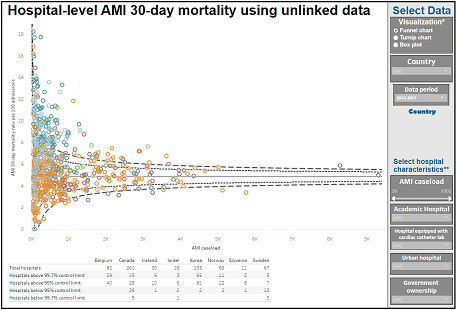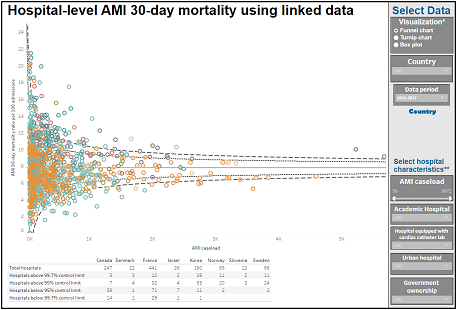Health policies and data
Hospital performance
|
Health spending on average represents 8.8% of GDP in OECD countries, ranging from 4.2% in Turkey to 17.1% in the United States. Hospitals account for nearly 40% of health spending. In most OECD countries, more than 80% of this expenditure is covered by government and compulsory schemes. Hospitals are thus important targets in national efforts to improve health system performance. The OECD currently collects a number of acute care measures of hospital performance on a national level. The mortality rate within 30 days of patients being admitted to hospital after an acute myocardial infarction (AMI) is one key hospital performance measure. The measure reflects processes of care such as timely transport of patients and effective medical interventions. This indicator is also influenced by differences in hospital transfers, average length of stay, and AMI severity. Several effective strategies to lower AMI mortality rates in OECD countries have been identified. |
|
HOSPITAL PERFORMANCE PROJECT
The OECD launched the Hospital Performance Project in 2015 to understand hospital performance across countries and to strengthen international comparisons. The project built on international initiatives such as the ECHO and euroHOPE Projects and expanded these approaches to all OECD countries.
Following two years of methodological work, risk adjusted, hospital-level 30-day AMI mortality rates were collected for over 3,000 hospitals across 12 OECD member countries for the years 2013 to 2015. Additional information on this methodology including risk adjustment and indicator definitions are available in documents included in the Further reading section below.
The scope and scale of this data collection are groundbreaking, being the first time hospital-level performance data have been collated and compared across OECD countries in America, Europe and Asia. Results are published in the OECD’s flagship publication Health at a Glance 2023: OECD Indicators (see Chapter 6 on Quality and Outcomes of Care).
The OECD is now expanding the hospital performance work beyond AMI mortality to include a focus on stroke mortality.
|
Access the data visualisation / Download the underlying dataset |
Access the data visualisation / Download the underlying dataset |
While the linked data based method is considered more robust, it requires a unique patient identifier to link the data across the relevant datasets which is not available in all countries.
FURTHER READING
- Health at a Glance 2023: OECD Indicators, see Chapter 6 on Quality and Outcomes of Care (November 2023)
- Methodological development of international measurement of acute myocardial infarction 30-day mortality rates at the hospital level, OECD Health Working Papers No. 114 (December 2019)
- Does size matter? The impact of caseload and expertise concentration on AMI 30-day mortality-A comparison across 10 OECD countries, Health Policy, Volume 123, Issue 5, May 2019
- Cardiovascular Disease and Diabetes: Policies for Better Health and Quality of Care, OECD Health Policy Studies, OECD (2015)
CONTACT US
For more information, please contact hcqo.contact@oecd.org

Follow us on Twitter @OECD_Social
Related Documents


